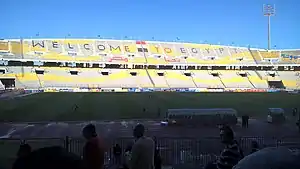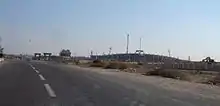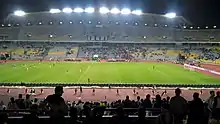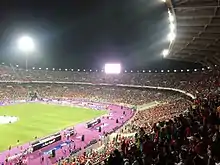Borg El Arab Stadium
The Borg El Arab Stadium (Arabic: ستاد برج العرب), sometimes referred to as the Egyptian Army Stadium or El Geish Stadium - Alexandria (Arabic: ستاد الجيش ببرج العرب), is a stadium commissioned in 2005 in the Mediterranean Sea resort of Borg El Arab; 25 km west of Alexandria, Egypt. It is the largest stadium in Egypt and the second largest in Africa (after FNB Stadium in Johannesburg) with a capacity of 86,000[1] and is an all-seater. It is also the 27th largest stadium in the world, and the 9th largest association football stadium in the world. It is located on the Cairo-Alexandria desert highway 10 km from Borg El Arab Airport and 15 km from Alexandria's city center. A running track runs around the pitch, and the ground has four large floodlights. Only one stand is covered by a roof.
 | |

| |
| Location | Borg El Arab, Egypt |
|---|---|
| Capacity | 86,000 |
| Record attendance | 86,000 (Egypt 2–1 Congo) (8 October 2017) |
| Field size | 105 m × 70 m (344 ft × 230 ft) |
| Surface | Grass |
| Construction | |
| Broke ground | 2005 |
| Opened | 2009 |
| Architect | Egyptian Armed Forces |
| Tenants | |
| Egypt national football team Smouha Al Ahly (selected matches) Al Ittihad (selected matches) | |
The stadium is 145 feddans (609,000 sq m), is surrounded by a fence which is 3 km long, an internal road network its long is 6 km, a parking lot which could fit 5000 cars and 200 bus beside an airstrip, there are 136 electronic entrances. The main cabin is covered by an umbrella which covers 35% of the stadium total area, and it is considered the biggest umbrella in the Middle East. Its length is 200 m, its dimension is 60 m and its area is 12,000 m2, which is equal to 3 feddans.
The stadium is air-conditioned and that condition includes the clothes chambers, the salons and entrances, also the stadium includes 8 elevators for broadcasters, handicapped, services and important persons. There are 2 sub-stadiums for training and each ground can hold 2000 spectators, includes 2 locker rooms and a stadium for Athletics. The stadium also includes a hotel for 200 guests which is air-conditioned and has a swimming pool, gym and a department building which contains 80 people. The stadium includes a building which contains 300 presses. This building includes cabinets for broadcasters, entrances for emergency, ambulance cars, 39 and cafeterias, 337 bathrooms which classified to 33 bathrooms for women and 8 bathrooms for the handicapped.
History
Background

The Stadium was originally commissioned as part of an ambitious 5 international-standard stadiums project for Egypt's bid to host the 2010 FIFA World Cup.[2] After the Egyptian bid to host the World Cup failed, the stadium became the home stadium of the Egyptian national team alongside the Cairo International Stadium. Alongside the national team, Alexandria-based side Smouha started to play their home matches on the stadium instead of Alexandria Stadium since 2016; while Al Ahly, Al Ittihad, Al Masry and Zamalek also played some of their home matches their due to different reasons.
The stadium is unique in that it was designed and built completely by the Egyptian Armed Forces Corps of Engineers (EAFCE).
Opening
To utilize the new stadium, Egypt chose Borg El Arab stadium to be among the stadiums hosting the 2009 FIFA U-20 World Cup. In an inspection tour to check Egypt's readiness, Jack Warner, FIFA Vice-President and head of the inspection delegation, spoke very highly of the stadium. He said, "It is a fantastic stadium. It is one of the best in the world".[3] Other delegation members described the stadium as an identical copy of the Stade de France. The stadium, however, hosted only one match in that tournament, which was the opening match between Egypt and Trinidad and Tobago as well as the opening ceremony of the competition.[4] FIFA President Sepp Blatter expressed his delight to be at the "fantastic" stadium of Borg El Arab as he watched the high-tech visuals and fantastic lights show of the opening ceremony.[5]
Description
Location

Borg El Arab has been selected to be the location of this project. Borg El Arab is located 7 kilometers away from the 31 kilo meters mark at the Cairo-Alexandria desert high road. It is also about 10 kilometers away from each of Borg El Arab Airport, Mubarak Emergency Hospital (at Sidi Krir), and tourist villages in the northern coast. The site is also 1.5 km away from the train station at king Mariot. The sea resort of Borg El Arab is known for its pollutants-free and dry climate due to the fact that it is 28 meters above sea level.
The area of land specified for this project is 600,000 m2 (145 acres) divided as follow: 30% for facilities, 30% for roads and waiting areas, 40% for green areas. This project is planned to be the building brick for a full Olympic Village integrated.
Entrances and exits
A 3.5 km long fence surrounds the entire stadium. There are 10 gates and 80 shops with a total surface area of 4 thousand square meters. The main stadium is surrounded by 1.2 km long fence that controls the spectators entrance. This fence contains 17 gates and a total of 136 electronic machine that allow the entry of 800 spectators per minute. While stadium could be completely filled within two hours, it could be entirely evacuated in less than 8 minutes.
Beyond the gates, there are 76 staircases divided into 22 up to the upper stands, 18 down to the special cabins, 36 down to the lower stands. Other entrances exist for the VIP, handicap, and for people with special needs. The stadium contains 8 elevators: two elevator for VIP, two for journalists, two for shipments and goods, and other two for people with special needs.
The stadium includes the following entrances: one for pitch, one for Marathon, two for emergency ambulance and fire services, one for the players and media personal, and two for groups and celebrations.
Pitch

The geographical direction of the pitch is about 12 degrees north west in order to be along the direction of the wind. The reason for that is to avoid any obstruction to the movement of the ball or the players according to the requirements of the International Federation of Football Associations (FIFA). The pitch dimensions is 105 * 70 meters. In addition to the pitch, the stadium is equipped to host Olympic Games activities; 8 running track lanes, water blocker for steeplechase, two sand pit for long jump, one sand pit for triple jump.
The main stadium is equipped with twin light towers positioned at the north-eastern and south-eastern stands of the stadium at a height of 65 meters above the pitch. In addition, lighting sources are installed along the sunshade. Two results panel and 13 prepared positions for cameras are ready.
In addition to the pitch, there are two training fields with a seating capacity of 2000 spectators per field. Both fields occupy a total area of 3,000 m2, where each field includes athletics track, two changing rooms for the players, two changing rooms for the referees, offices, and restrooms. Both training fields are equipped with lighting towers.
Seating capacity
Borg El Arab's main stands can accommodate for 86 thousand spectators on the upper and lower levels. The stadium's seating orientation was designed to allow the spectator to view all the pitch's angles in full without any impediments. While the exclusive VIP cabin has 22 seats, the terrace can accommodates for 300 spectators. The media personal stand can include up to 300 journalists. An outside stand is available for people with special needs.
The terrace and first class stand, which represents 35% of the total stadium seating capacity, are covered with a metal sunshade that is 200 meters long and 62 wide. The metal sunshade is lifted by 18 concrete lotus flower-shaped columns to a height of 32 meters. The sunshade is pulled by high-resistive steel cables. This sunshade, the largest one implemented in the region by Egyptians, used 35 tons of steel in manufacture.
Available services
Four rooms for clothes changing, with restrooms and showers included in each, are available for the players. In addition, two warm up rooms, number of offices for coaches and medical staff, several rooms for the referees, sports halls, medical centre equipped with the highest level analysis-laboratory, and a press centre for media coverage are available.
For the spectators, there are 32 restaurants and 68 restrooms (a total of 386 toilets; 337 for men, 43 for women, and 6 for people with special needs). Twenty five percent of the stadium is air conditioned, this includes the terrace, salons, clothes changing rooms, and media centre. The audio and surveillance cameras are accessed at the control room found in the basement. An information transmission network and a network of fire alarms are linked to a central control room found at the highest point of the stadium.
The stadium includes a hotel for the players that includes 200 bed which are air conditioned. The hotel includes a conference hall, a cafeteria, restaurant, swimming pool, a gymnasium and provider of elevators. In addition for the hotel, there is also an administrative building and a housing centre for the stadium's workers with a total capacity of 80 people (total area is 3500 square meters). This building includes several offices, salons, a dining hall, rooms accommodation. The stadium includes an internal road network that is 6 km long, car parking capacity of 5 thousand cars, and 200 buses and a helicopter landing pad with capacity of 4 aircraft.
The site green areas occupy a total of 250 thousand square meters. The site has been feed 4 Mb electricity capacity, backup power generators, 500 local phone lines, 1500 international phone lines, a ground water tank with 2000 square meters capacity, and a draft sewer capacity 800 m.
Gallery
 A view of Borg El Arab Stadium in 2005.
A view of Borg El Arab Stadium in 2005. A view of the stadium while it was under construction in November 2005.
A view of the stadium while it was under construction in November 2005. A view of the stadium while it was under construction in November 2005.
A view of the stadium while it was under construction in November 2005. Borg El Arab Stadium before a friendly match in March 2017.
Borg El Arab Stadium before a friendly match in March 2017. Borg El Arab Stadium during a friendly match in March 2017.
Borg El Arab Stadium during a friendly match in March 2017. Borg El Arab stadium before a match in the 2017 CAF Confederation Cup in April 2017.
Borg El Arab stadium before a match in the 2017 CAF Confederation Cup in April 2017. Borg El Arab Stadium during a match in the 2018 FIFA World Cup qualifiers in October 2017.
Borg El Arab Stadium during a match in the 2018 FIFA World Cup qualifiers in October 2017.
References
- "The boys are ready", Al-Ahram Weekly, Al Ahram Publishing House (965), 17 September 2009, archived from the original on 10 October 2010, retrieved 6 June 2010
- "The stadiums and their cities" Archived October 31, 2010, at the Wayback Machine. Al Ahram Weekly, 2003-12-31. Retrieved on 10 June 2010.
- Mazhar, Inas "Test tour" Archived October 11, 2010, at the Wayback Machine. Al Ahram Weekly, 2008-03-19. Retrieved on 10 June 2010.
- Pugmire, Jerome (25 September 2009), "Blatter kicks Maradona while he's down and says Argentina in 'crisis'", The Scotsman, Johnston Press, retrieved 6 June 2010
- "Egypt welcomes the world" FIFA, 2009-9-24. Retrieved on 10 June 2010.
External links
- "Details for Borg El Arab Stadium, Borg el Arab". worldstadia.com. Archived from the original on 6 March 2012. Retrieved 5 June 2010.